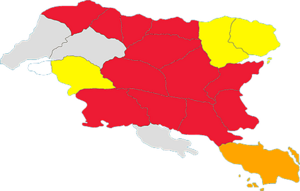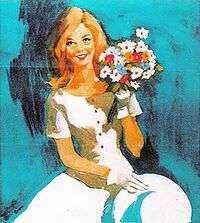Gylian federal election, 1969
| |||||||||||||||||||||||||||||||||||||||||||||||||
All 285 seats in the Chamber of Deputies All 400 seats in the Senate 143 Chamber of Deputies seats and 201 Senate seats needed for a majority | |||||||||||||||||||||||||||||||||||||||||||||||||
|---|---|---|---|---|---|---|---|---|---|---|---|---|---|---|---|---|---|---|---|---|---|---|---|---|---|---|---|---|---|---|---|---|---|---|---|---|---|---|---|---|---|---|---|---|---|---|---|---|---|
| Turnout | 94,7% | ||||||||||||||||||||||||||||||||||||||||||||||||
| |||||||||||||||||||||||||||||||||||||||||||||||||
 | |||||||||||||||||||||||||||||||||||||||||||||||||
| |||||||||||||||||||||||||||||||||||||||||||||||||
Federal elections were held in Gylias on 22 January 1969, to elect the 285 members of the Chamber of Deputies and 400 members of the Senate.
The incumbent Darnan Cyras government was re-elected with minor losses at the height of the Golden Revolution. The main highlight of the election was the appearance of the LSD Party, whose tongue-in-cheek campaign and platform made it the largest non-inscrit party, thus cementing the colourful character of Gylian elections.
Electoral system
Both chambers of the Gylian Parliament were elected through single transferable vote, using the Droop quota.
The Chamber of Deputies was elected using 5-member circonscriptions, drawn by Elections Gylias based on regional populations.
The Senate was elected by regions, each electing 20 senators.
Parties were not allowed to nominate more than one candidate per seat.
Parties
Background
In the 7 years since the previous federal election, the Golden Revolution had begun, and was in full flower. The combination of a booming economy with radical social revolution translated into a climate of widespread prosperity and revolutionary exuberance, notably manifested in a flourishing pop culture scene that found success abroad, and transformation of transformation of gender and sexual norms.
Although the Darnan Cyras government benefited from good domestic conditions, the consolidation of the Gylian consensus, and its role in encouraging the Golden Revolution, it was not completely unchallenged during this time. The big electoral blocs increasingly lost ground to the Non-inscrits once the unique circumstances of the 1962 federal election dissipated, a trend first visible in local elections. The government's turn towards a withering away of the state position in the last years of the Liberation War caused lingering controversy, which erupted in a brief flaring of protests by "anarchaotics" in 1968.
Inspired by contemporary protests in Akashi and Delliria, the "anarchaos" protests were unsuccessful — broadly unpopular due to their egoist tendency, unclear grievances, and attempts to instigate fights with the widely-respected Gylian Police. The government partly defused the protests by organising a referendum in September 1968 on "abolition of the state" and encouraging voters to vote invalidly, resulting in its invalidation. The "anarchaotics" founded the LSD Party as a political vehicle, but were quickly expelled due to a factional battle, and the party instead adopted acid communism as its main ideology.
The protests also benefited the National Reconstruction Alliance, which leveraged its image-based politics and lack of clear ideology to win support from voters who were exasperated with "anarchaotics", and would've otherwise been inclined to support more right-wing parties.
Another significant political force to emerge was the Movement for Emancipation and Democracy, which seized left-wing populist ground with its economic nationalism and the charismatic leadership of Maria Elena Durante. Before the election, it formed a political alliance with the New People's Party; the two parties fielded joint candidates and ran a united campaign.
Campaign

With the Golden Revolution ongoing, the established electoral blocs' campaigns were compared by some commentators to a "comedown" from the heights of 1962. Their collective manifestos were more modest in aims, and their campaigning took a more comfortably subdued tone.
The Progressive Alliance, as the incumbents, went into the election with comfortable advantages: high popularity, the successes of the Golden Revolution, respected cabinet ministers, and indirect support from the Revolutionary Communications Office. Their main challenge was described by the Democratic Communist Party's Jessica Freeman as "revolutionary complacency": the risk of becoming too established as incumbents and losing touch with the popular agitation that drove the social revolution.
Their collective manifesto was the target of parodies: compared to the utopian goals of constructing a new society 7 years prior, it largely promised a continuation of the Golden Revolution, and its sole major promise was a reform of local government to establish regional governments. Nevertheless, its advantages seemed enough to see it through. Its high-budget PPBs and posters became famous in the election, particularly the petite république poster, which personified Gylias as a young woman — closer to Ana than Lisa — and successfully made the case for the government's collective "guardianship" until impending "maturity".
The Liberal Union took their usual role as pragmatic foils for the more utopian PA. This campaign saw them play down economic policy — found to not make much headway among the current electorate — in favour of themes of political reform, individual liberties, and a philosophy of rights. They supported the establishment of regional governments, but their proposals to reduce the threshold for constituting municipal government were less popular, and rejected in a 1968 referendum.
The Centre Group were a known quantity as the official opposition, and Sasa Ruişela proved a foresitter in the vein of Beatrice Albini: commanding broad public respect that failed to translate at the ballot box. By this point, the ongoing "constructive"–"recalcitrant" war and resulting concentration of centre-right politicians in the CG frustrated Gylian centrists, one of whom remarked, "We have a left bloc, a centre-left bloc, a centre-right bloc, and a right bloc, but no centre."
The Revolutionary Rally, Conservative Coalition, and Front for Renewal of Order and Society remained marginalised, and practically nonentities during the campaign. The RR's anti-"anarchaos" stance in 1968 backfired on it, by worsening its perception as "old left dinosaurs", obsessed with economics and reactionary on social issues. The compositions of the CC and FROS changed slightly due to certain parties being shut down for anti-constitutional activities.
The Non-inscrits proved the stars of the campaign, and the new LSD Party its main attraction. Boasting an acid communist stance and a charismatic foresitter in Hildegard Wirner, the party used satire to make its point, and humorously embraced drugs as a force of revolutionary liberation. It ran on the slogan Gylias needs LSD, and its platform included pledges to create state-owned "oxygen clinics", adding LSD to the national water supply (parodying conspiracies around water fluoridation), and establishing Special Tourist Districts for sex tourism.
Maria Elena Durante campaigned heavily for the MED–NPP alliance, and her left-wing populist platform and demagogue rhetoric found an appeal among voters who were skeptical of the Golden Revolution's ambitions, but were not social conservatives or reactionaries. Similarly, the National Reconstruction Alliance benefited from attracting voters who were exasperated by the "anarchaotics" but staunchly opposed to right-wing parties; Emilia Malandrino even used the PPBs to promote ARENA as a harmless protest vote.
Results
In accordance with electoral law, the results were embargoed until the full counting and transfers were completed, and were released all at once on 25 January.
| Parties and blocs | Chamber of Deputies | Senate | |||||||||
|---|---|---|---|---|---|---|---|---|---|---|---|
| FPV | % | ± | Seats | ± | FPV | % | ± | Seats | ± | ||
| Progressive Alliance | 1.860.697 | 32,7% | 89 | 1.733.992 | 30,4% | 90 | |||||
| Liberal Union | 1.403.853 | 24,6% | 57 | 1.341.682 | 23,5% | 84 | |||||
| Non-inscrits and independents | 1.218.621 | 21,4% | 76 | 1.504.893 | 26,4% | 158 | |||||
| Centre Group | 1.061.806 | 18,6% | 59 | 977.745 | 17,2% | 68 | |||||
| Revolutionary Rally | 85.410 | 1,5% | 2 | 84.814 | 1,5% | 0 | |||||
| Conservative Coalition | 54.470 | 1,0% | 1 | 48.981 | 0,9% | 0 | |||||
| Front for Renewal of Order and Society | 10.375 | 0,2% | 1 | 7.149 | 0,1% | 0 | |||||
| Total | 5.695.232 | 100% | — | 285 | — | 5.699.256 | 100% | — | 400 | — | |
| Registered voters and turnout | 6.071.040 | 94,7% | |||||||||
Analysis
The results of 1962 were largely repeated: no bloc won a majority by itself, the PA maintained their plurality in both chambers, and the LU remained close behind in first preference votes. Although the CG finished third in first preference votes, they managed to win 4 more deputies than the LU, advancing them to second-largest bloc in the Chamber of Deputies.
Despite first preference vote losses of 3%–5% for the Chamber of Deputies and 6% for the Senate, the PA–LU alliance managed to hold on to most of its seats. The PA only lost one deputy, while the LU lost 7 deputies and 5 senators.
The non-inscrits performed best, and the LSDP played a key role in this, becoming the largest non-inscrit party. The non-inscrit bloc's first preference vote increased by over 10% in both chambers, although due to the multiple parties and electoral system, it translated into modest gains: 10 new deputies and 9 new senators. Other notable beneficiaries were ARENA and the MED–NPP alliance, both of which won the maximum 20 Senate seats possible for a party.
The RR and CC experienced further losses, while the FROS remained stagnant.
At the regional level, the PA once again swept mainland Gylias while the LU held their strongholds of Arxaþ, Alţira, and Elena, and the CG its stronghold of Nerveiík-Iárus-Daláyk. The non-inscrits built on their previous performance, winning a plurality of deputies in Nauras, Kausania, and Tandar, and coming a close second in Mişeyáke, Nezyál, and Herlan.
Many anarchist-leaning voters dissatisfied with the PA's performance in government switched to the LSDP.
Aftermath
The new Parliament was sworn in on 1 February 1969. The Darnan Cyras government was returned with minor losses: it held onto a majority in the Chamber of Deputies and was now 7 seats short a majority in the Senate.
The CC was destroyed by the election: reduced to only one deputy, it underwent entryism by "constructives" and its member parties were all abolished, replaced by the progressive conservative National Bloc. This ushered a period of political realignment, with many centre-right politicians previously elected under the CG, non-inscrit, or independent banner joining the NB parties instead, leaving the CG as a centrist formation. The NB performed very well in the first regional elections of 1970, municipal elections of 1970, and the presidential election of 1975, raising expectations they would become a serious contender in the next federal election.
The MED's campaign approach and results are seen by historians as a forerunner of the RR's rise during the wretched decade; indeed when the MED disbanded due to Maria Elena's death in 1972, much of its former support transferred to the RR.



